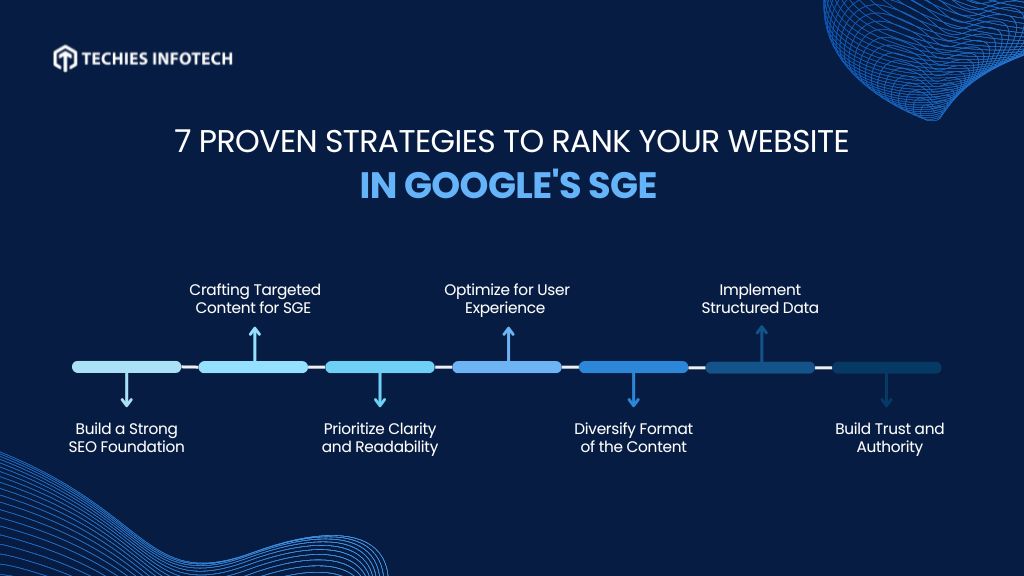Clicking through links and scrolling through multiple pages, desperately searching for the answer buried within a website – that’s the classic image of a Google search.
Scrolling past sponsored ads, deciphering meta descriptions just to find the right website that can provide the piece of information you were looking for.
But Google’s Search Generative Experience (SGE) is here to change how we Google. It marks a move from simply providing links to offering users comprehensive answers directly within the search results page.
With Search Generative Experience potentially offering the answers directly on the search page, the amount of organic traffic websites have enjoyed over the past few years can drop significantly unless your website ranks in the top results of SGE.
What is Search Generative Experience?
Google’s Search Generative Experience is a new way of searching on Google, where the search engine provides direct answers to user queries on result pages without the need to click through to a website.
SGE uses generative AI to answer users’ queries and offers links to websites that support the answers generated. Currently, Google displays SGE results above the organic website links and paid results on SERPs.

Unlike featured snippets that provide answers as fragments of text from a single website, SGE generates an answer for the query by taking information from multiple sources.
Types of SGE Results

In Google’s result pages, the SGE panel appears with a link to the “Show more” button. Sometimes, the search engine provides users an option to generate SGE results by clicking on the “Generate” button.
SGE results appear in different forms for different types of queries. Here is a breakdown of the kinds of results you can get at SGE:
- Answer Box: SGE often delivers the answer directly within the search result page, eliminating the need to click through multiple links. This answer box can include short paragraphs, bulleted points, images, and other informative snippets tailored to your specific query.
- Article Links: Article links are generated below the short paragraph in the SGE results. These article links are the sources from where the information is pulled.
- Product Recommendations: For product-related search queries, SGE showcases featured product recommendations.
- Infographics: SGE can also generate infographics to provide answers to complex queries.
How to Rank Your Website in Google’s SGE?
While Google’s Search Generative Experience is still in the experimental stage, it’s poised to revolutionize how users interact with search results. Since SGE can potentially reduce website traffic, it is important to understand its ranking system to capture the customer base. Here are seven proven tactics to optimize your website for SGE:

1. Build a Strong SEO Foundation
Ensure your website ranks well on targeted keywords in search results. If your website ranks higher in standard search result pages, ranking in SGE will be much easier. This means SGE uses many ranking factors that are similar to standard SEO. A solid SEO foundation includes technical SEO aspects like page speed, mobile-friendliness, and a clean website structure. Here’s what you should focus on:
- Content Quality with relevant keywords
- Strong user experience
- Mobile-friendliness
- Quality backlinks
- Internal linking
However, ranking in the organic results of standard SERPs is not the only factor in getting your website featured in SGE results.
2. Crafting Targeted Content for SGE
While a strong SEO foundation is crucial, Google’s Search Generative Experience (SGE) demands a shift in content strategy. Here’s how to create content that resonates with SGE and increases your chances of ranking within its results:
- Match questions and topics in search queries closely: Understand the specific questions and topics users are searching for. Analyze search queries and user behavior clearly to identify the information they truly need.
- Focus on user intent: Move beyond simply adding keywords to the content. Understand the “why” behind a search query and provide content directly addressing the user’s intent. Aim to answer their questions comprehensively and leave them feeling informed, not needing to click further.
- Target relevant long-tail searches: Target longer, more specific search queries with lower competition. These queries often reveal a deeper understanding of the user’s intent, allowing you to tailor your content for a more focused audience.
3. Prioritize Clarity and Readability
Clear and concise content is essential for ranking your website in SGE. Users rely on search engines to find precise answers to their questions. Ensure that the content on your website is clear and easy to understand. Here’s how to optimize your content for readability:
- Simple and Clear Language: Avoid technical terms and jargon that might confuse your audience. Use concise and direct language that anyone can understand.
- Use Short Sentences: Write content in short sentences and simple language. Like featured snippets, SGE prefers short paragraphs and sentences over complex paragraphs.
- Proper Formatting: Use clear headings, subheadings, and pointers to break down complex information and improve scannability.
- Concise Explanations: Strive for clear and concise explanations, avoiding overly long sentences or dense paragraphs. Aim for a conversational tone in the content to keep readers engaged.
- Visually Appealing Content: Utilize high-quality images, infographics, and videos to enhance understanding and break up text-heavy sections.
4. Optimize for User Experience
If you want Google’s SGE to cite your website in the results and push visitors to click on the link, your website needs to have what people want to visit. Google prioritizes websites that offer a positive UX, which directly translates to user satisfaction. Here’s how to optimize your website for an exceptional user experience:
- Mobile-Friendliness: The majority of searches happen on mobile devices. Ensure your website offers a responsive design that adapts seamlessly to different screen sizes and devices.
- Fast Loading Speeds: Slow loading times can frustrate users and negatively impact your ranking in SGE results. Optimize your website for speed by reducing code bloat, optimizing images, and leveraging caching mechanisms.
- Clear Navigation: Make it easy for users to find the information they need. Implement a clear and intuitive navigation structure with well-defined menus and categories.
- Visually Appealing Design: A visually appealing design can enhance user engagement. Use high-quality images, videos, and white space to create a clean and aesthetically pleasing experience.
- Limited Distractions: Avoid excessive pop-ups, intrusive ads, or distracting elements that can hinder the user journey.
5. Diversify Format of the Content
SEO recognizes that users have different preferences when searching for something on Google. To cater to diverse audience needs, consider incorporating various content formats into your strategy:
- Informative Text: High-quality, well-researched articles remain a cornerstone of content marketing. Ensure your text is clear, concise, and addresses user intent comprehensively.
- Visual Appeal: Break up text with compelling visuals like infographics, charts, and diagrams. These elements can effectively communicate complex information in an easily digestible format.
- Engaging Videos: Videos are powerful tools for capturing user attention and delivering information dynamically. Consider creating explainer videos, product demonstrations, or interviews with industry experts.
6. Implement Structured Data
Structured data plays a crucial role in SEO and is an important factor for ranking in SGE. It acts like a roadmap for search engines, providing them with clear instructions about the type and meaning of your content. Here’s how implementing structured data can benefit your website:
- Enhanced Understanding: Structured data helps search engines understand the specific elements within your content, such as recipes, products, events, or locations. This allows them to present your content more effectively within SGE results.
- Rich Snippets and Features: Structured data can increase your chances of appearing in rich snippets and featured results within SGE. These enriched content pieces can make your website stand out and attract more user clicks.
- Improved Relevancy: Structured data provides clear information about your content, helping search engines determine its relevance to specific user queries. This can improve your ranking within SGE results for relevant searches.
7. Build Trust and Authority
While SGE introduces new considerations, it doesn’t negate the importance of Google’s E-E-A-T (Experience, Expertise, Authoritativeness, and Trustworthiness) framework. While E-E-A-T is not directly a search engine ranking factor, it is an essential component of Google’s Search Quality Evaluator Guidelines. As a rank-boosting factor, it can help increase your page rank in standard search results and SGE. Here’s how to enhance your E-E-A-T and establish yourself as a credible source:
- High-Quality Content: Focus on creating informative, well-researched content that demonstrates your expertise in the niche. Content should be factually accurate, up-to-date, and provide genuine value to users.
- Author Expertise: Consider including author bios in the content and establish the authors’ credentials and expertise that highlight their qualifications and experience in the relevant field.
- Backlinks from Reputable Sites: Earning backlinks from high-quality websites in your niche is a powerful way to signal trust and authority. Focus on creating link-worthy content that other websites would naturally want to reference.
- Positive Online Reputation: Maintain a positive online reputation by promptly addressing user reviews and comments. Show commitment to delivering outstanding service and addressing any user concerns.
Conclusion
Google’s Search Generative Experience signifies a paradigm shift in searching for information online. While ranking in SGE results can seem daunting; the new feature presents a tremendous opportunity for businesses to rank their websites in these results.
By building a strong SEO foundation, prioritizing user needs, crafting clear and concise content, and optimizing for a positive user experience, you can rank your website in SGE.












